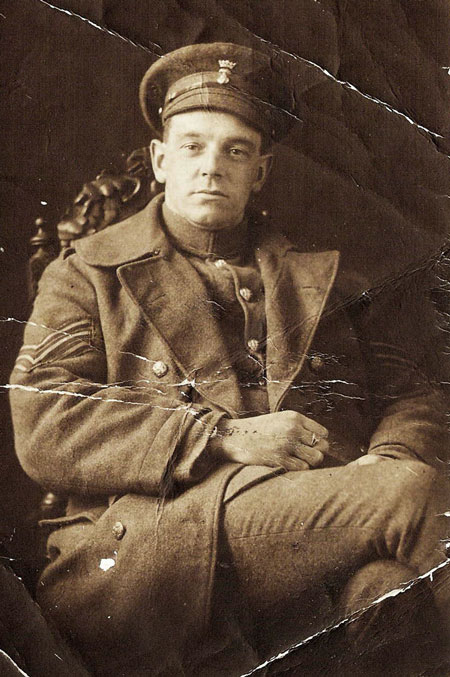Sergeant William Ewart Gladstone Lockhart
William Ewart Gladstone Lockhart was born on 18 August 1888 at Knockduff, Mullaglass, County Armagh, the last of six children of farmer and auctioneer John Lockhart and his wife Margaret Kynaston Lockhart (nee Rowland). By 1911 he was living at Knockduff with his parents and one older brother and working as a clerk.
Lockhart enlisted in the North Irish Horse between 19 March and 8 April 1909 (No.346), serving in D Squadron (Dundalk). He may also have served in the North of Ireland Imperial Yeomanry from 1906 to 1908, as one record suggests. This would help explain his rapid rise to the rank of sergeant following his enlistment in the North Irish Horse.
Lockhart was an accomplished marksman, and at the regiment's annual training camp in 1914 he won the Enniskillen Cup, scoring six bull's eyes out of eight shots.
On 17 August 1914 he embarked for France as part of A Squadron, seeing action on the retreat from Mons and advance to the Aisne.
It is possible that later in the war Lockhart returned to the UK either wounded, ill or injured, after his recovery serving at the North Irish Horse base depot at Antrim. Prior to mid-1917 he returned to France, where he may have been posted to either A or B Squadron of the 2nd North Irish Horse Regiment.
In September 1917 the 2nd NIH Regiment was dismounted and most of its men, together with some surplus men from the 1st NIH Regiment, were transferred to the 9th (Service) Battalion, Royal Irish Fusiliers – re-named the 9th (North Irish Horse) Battalion. Lockhart, like most of the men, was transferred on 20 September. He was issued a new number – 41543 – and posted to A Company. He probably saw action with the battalion at the Battle of Cambrai in November and December 1917.
On 17 January 1918 the 9th (NIH) Battalion moved to Grand Seraucourt, on the St Quentin front.
Private Lockhart was posted as missing following the retreat from St Quentin from 21 to 27 March 1918. He had been captured on the 27th at Erches, when much of the battalion was surrounded by the rapidly advancing German forces. He was held as a prisoner for the remainder of the war, at Cassel (Niederzwehren) and Gefangenlager 3, Camp III in Munster. While there he sent a number of letters home to family and friends, including these:
13th April 1918
Dear Mother,
Well I am sure you will be anxious to know as to my whereabouts. I sent you a card a week ago, hope you received it, don’t be worrying as I am in a good camp & am quite well. Harold Barton is with me, T McIlroy, Cranky & a lot more of the chaps I knew. There are several things I want, Tobacco, Pipes, matches, Carbolic soap, razor etc. I believe the Red Cross fund supply parcels, with subscriptions being sent. Tell Chas to write to Trimble of the “Armagh Guardian” & he will give him full particulars as he has to do with the 9th Batt R.I. Fusiliers.
With Love, Willie.8th May 1918
Dear Mother,
Well it is time for letter writing again twice a month, a card every week is allowed, so I hope you will get them although I believe it takes a long time from they leave here. I am keeping quite well so I am sure this is the best news I can give you. I hope you are keeping well yourself, Charles, Rowland, Maggie and the little girl. I will be glad when I get a letter of course, they are delayed a lot here, then write as plain as you can as everything is looked at. The Sergts do not work unless they like, so when the parcels arrive, we should not grumble under the circumstances. The Red Cross Society for Prisoners of War keep us supplied, they say here that a parcel from home can only be sent every 3 months but as we hear very little news, anything we do hear you might not believe the quarter of it. Tell Charles I would like some of Masseys tobacco, pipe and pouch with some of Clarks plug. Remember me to all.
With Love, Willie(Above transcripts courtesy of Olive Nelson, William Lockhart’s granddaughter. 'Rowland' and 'Charles' were his brothers and ‘Maggie and the little girl’ Charles’s wife and daughter.)
17th June 1918
Dear Isaac,
I have been thinking of sending you a card or a letter since I was captured but as we are issued with a Post-card every week and a letter like this every other week, it was necessary to let all friends know first. You will see there is not much danger of writing too much especially on a P.C. however the news is not too plentiful so it does not matter. Well I suppose you will all think everything, & wonder how I am getting on. First of all I am having the best of health, in a very good Camp, & have no cause for to grumble now, so that is a lot to say. Well Isaac how are you all getting along, I have not got any letters or any thing since we were captured on the 27th March, our first Red-cross parcel will arrive in a day or so I believe, so, that means a lot to us, it takes about 5 to 6 weeks for a letter. I want you to write me a nice long letter, you will be able to let me know how you got the 12th [July] over, I hope you will all have a good time if this reaches you before then, no doubt I will be thinking of [LOL] 225 all the day & hope the next one will be a free one for me. Will you remember me to one & all of the members of 225 and any enquiring friends, let them know I am well. How is Jack, send him my address.
Yours sincerely,
W. Lockhart
Lockhart was released after the Armistice and returned to the UK in January 1919. He returned to Jerrettspass, near Newry, where he bought a farm. On 26 February 1922 he married Agnes Agnew. He died at Jerretspass on 4 June 1964 and was buried in the First Drumbanagher and Jerrettspass Presbyterian Churchyard. An obituary published at the time read:
Mr William Lockhart was an extensive and highly respected farmer in the Knockduff district of Jerrettspass. He was an esteemed member of Bessbrook Miniature Rifle Club in the days before the 1st World War and was an excellent marksman. In 1906 aged 18 he joined the North Irish Horse and during WW1 saw much service in France during that campaign, in which he was taken prisoner about six months before hostilities ended and was a member of the North Irish Horse Old Comrades' Assoc and also Newry Branch of the British Legion. A staunch member of the Presbyterian Church he worshipped in First Drumbanagher and Jerrettspass Presbyterian Church. The deep and sincere sympathy of his host of friends in the Bessbrook Mullaglass and Jerrettspass districts goes out to his wife and sons. The funeral took place on Saturday afternoon. It was an extremely large funeral and amongst the cortege were many of deceased's brethren and comrades, many coming from a distance to pay their final respects.
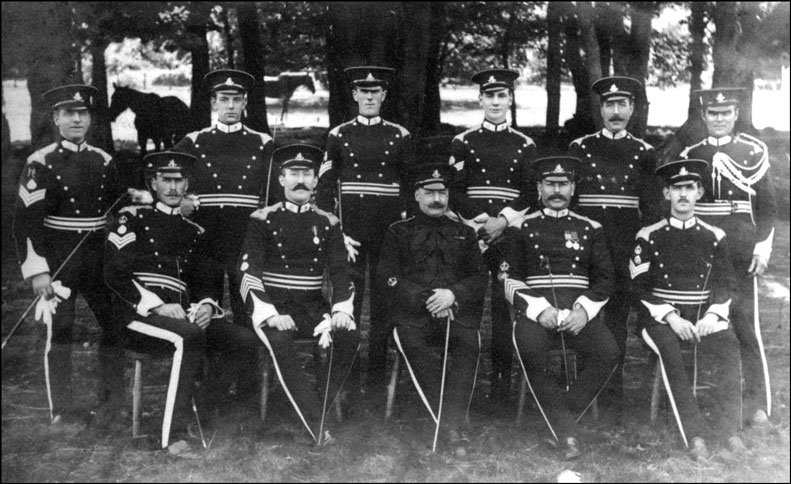
The picture above shows Sergeant Lockhart (standing, second from left) with D Squadron Sergeants in walking out dress at Newcastle in 1914.
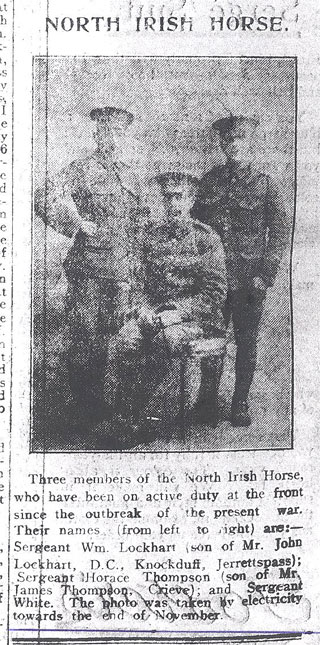
Newry Reporter, 3 December 1914
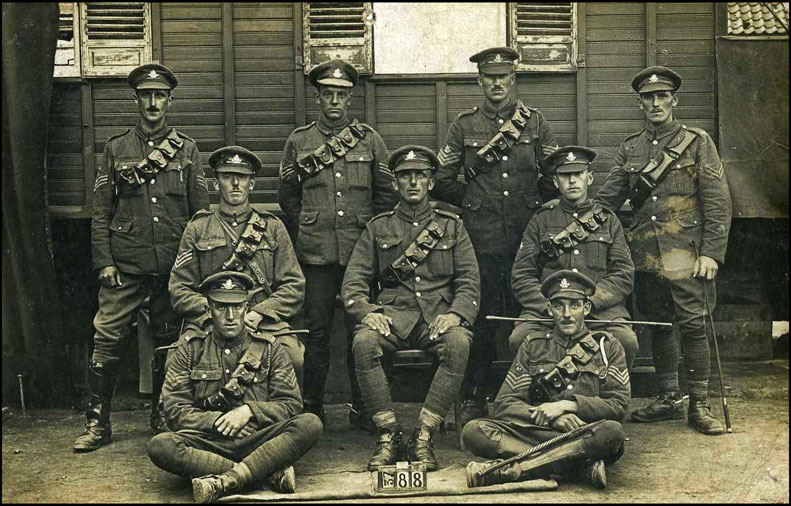
The picture above shows Lockhart (second from left standing) with A Squadron sergeants, probably in 1916 or 1917 in France. The man sitting, centre, is Warrant Officer Class 2 Humphrey Boyd.
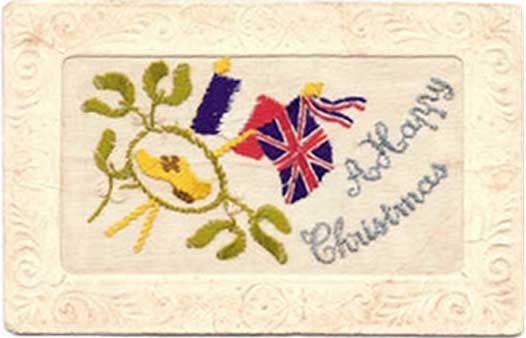
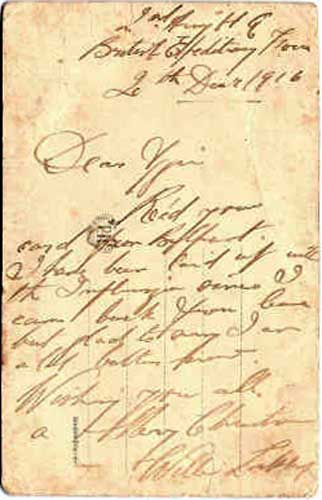
This silk postcard from Lockhart reads:
2nd Army HQ
British Expeditionary Force
20th Decr 1916
Dear Aggie, Rec'd your card from Belfast. I have been laid up with the Influenza since I came back from leave but glad to say I am a lot better now. Wishing you all a Merry Christmas
Willie Lockhart.
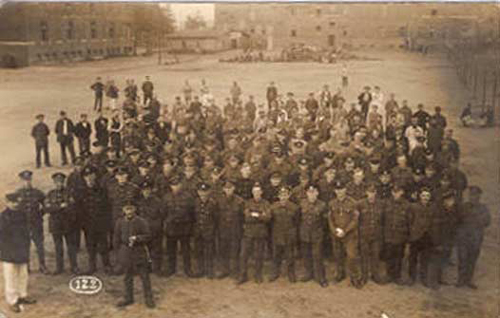
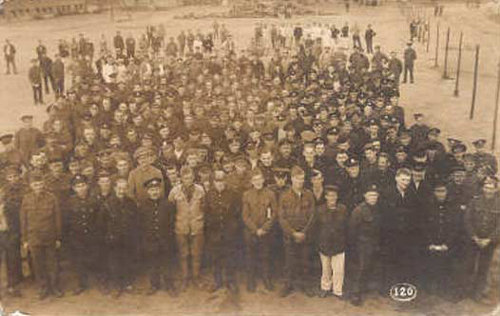
Postcards Lockhart sent home while a POW in Germany (in the first he is third from left at front, arms folded). Written on the reverse of one, to his brother, is:
30th April 1918
As you will see we have moved. This will be the address in the meantime. I am quite well and am getting settled down. How is everything at home. I will be glad when I get a letter. I mentioned in one of the cards for you to write to Trimble of the Armagh 'Guardian'. Send him my address with height for clothes 5ft 9ins and size 8.5 boots.
Love to Mother and all. Willie
I am grateful to William Lockhart's granddaughter, Olive Nelson, for allowing me to reproduce images 1,4,5,6,7 and 8, and the transcripts, and also to John Adams www.johnadams.org.uk/letters for permission to use Lockart's letter dated 17 June 1918. Image 2 is provided courtesy of the Public Records Office of Northern Ireland (Cat. No. D1482/9). Image 3 was provided by Joe Center.

